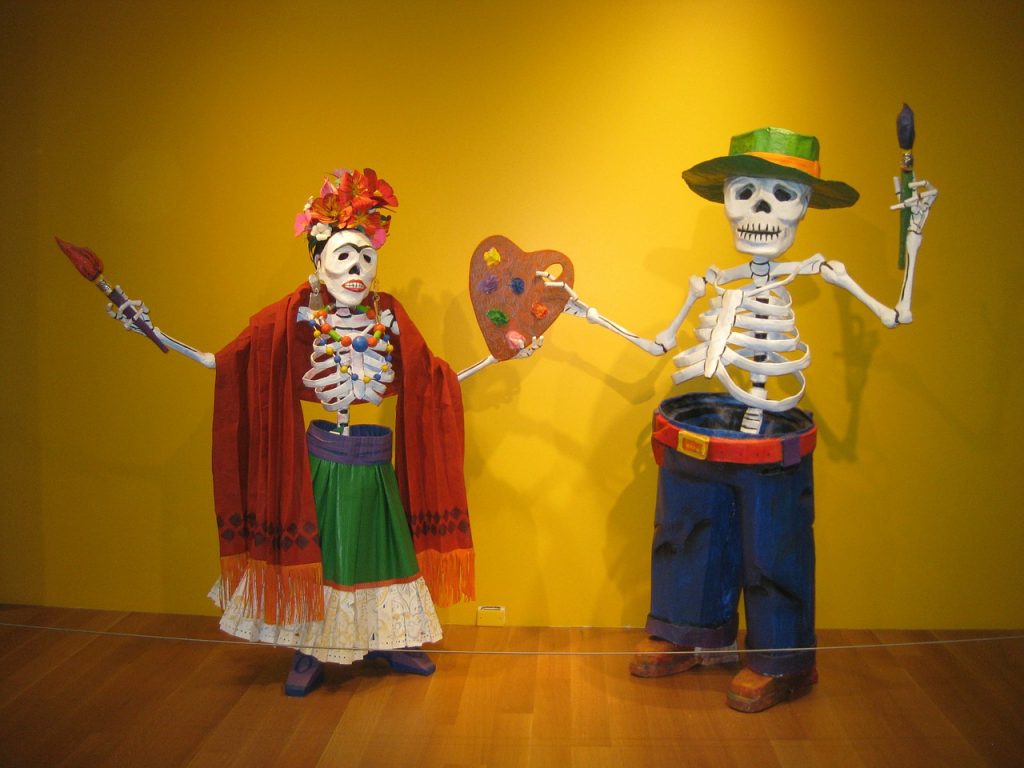Celebrate Halloween, el día de los muertos.
Too often when we’re learning a new language, we take the language out of context, and focus on the technicalities of grammar and vocabulary – forgetting the rich tapestry of culture, tradition and community which motivates us to learn a language in the first place.
El día de los muertos is a festival, which for many Mexicans across the world, is an essential part of the culture they belong to. We spoke to our Mexican correspondent (…a friend of mine, Ariana, who recently lived in Cholula, in Southern Mexico) to understand what the day is about, and how we can recreate some festive-magic from rainy London!

Really briefly, what is el día de los muertos all about?
Despite being called ‘el día’, the festival actually runs over 2 days, the 1st and 2nd November, and is a celebration of the dead. In Mexico, there’s a distinctly different attitude towards death than here in England, where death is usually considered only as a sad thing. El día de los muertos, is a time to remember and in particular, celebrate the dead, including ancestors. Some people in Mexico believe that the dead are actually with them for these two days – not most, but some.
How did people celebrate el día de los muertos while you were there?
I spent el día de los muertos in Lago de Pátzcuaro, which is a really famous place to go and celebrate it in Mexico. I took a boat in the middle of the night to the Isla de Janitzio, which is full of women whose faces are painted as calaveras (skulls). On the Isla (island), there’s a famous cemetery where families will make ofrendas (offerings or gifts) to the dead. Often, that’s things like alcohol, cigarettes, photos of family and flores naranjas (orange flowers) called cempasúchil (marigolds) in Náhutl the language from the Aztecs.

Families often take stools, and sit by the gravestones having picnics by candlelight, it’s really beautiful to watch. Lots of other towns have parades, and some make really long, intricate carpets out of orange flower petals.
How does Mexico keep the tradition alive?
It’s easy to see how this tradition will fade over time, in the year I was there, the university I was studying at hadn’t given a day of leave for el día de los muertos for the first time, and I remember that while some of the older staff were outraged, a lot of the students didn’t seem to mind. That’s why I think it’s quite important that people around the world know about the festival, and appreciate how beautiful and special it is.
It got quite famous when it featured in a James Bond movie, but some people I spoke to were annoyed that the film conflated el día de los muertos with Halloween, and portrayed it as a big party. In actual fact, the festival is usually celebrated as quite an intimate, family event, which is a celebration, but not a party in the sense that Halloween is.
How can we teach young Spanish-learners about el día de los muertos back in England?
There’s a few things you could do:
- The Disney movie Coco is a really good film which I can’t recommend highly enough. If your little ones are able to, they could watch it in Spanish, or English with Spanish subtitles. It’s colourful and fun, and a great introduction to the traditions, and cultural significance of el día de los muertos.
- Bake a Pan de Muerto bread, a tasty festive treat. You can mould the bread into different shapes, such as angels or animals. Another tasty Mexican tradition (although strictly for grown-ups) is Michelada cocktail, made with cerveza (beer), lime juice, assorted sauces, spices, tomato juice and chilli, all served in a salt-rimmed glass!
- Get some face-paint out and conjure up your best ‘La catrina’, the tall female skeleton who wears a fancy hat, and might loosely be based on an Aztec goddess of death.
Key Vocabulary
Pan de muerto – Bread of the dead
Calaveras – Skulls
cempasúchiles – Marigolds
Ofrendas – Offerings, or gifts
La Catrina – A particularly famous symbol of el día de los muertos, a tall female skeleton.
Micheladas – Mexican cocktails made with beer, lime juice, assorted sauces, spices, tomato juice and chilli.
Recipe for Pan de muerto
For a tasty recipe check this one.
If you want to Practice your Spanish as well as you baking check out this recipe.
If Mexican culture and cuisine has sparked your curiosity here is a good account to follow on Instagram: Mexican Food Memories by Karla Zazueta.

Decorations you can make: Papel picado
I hope you have fun with all these tips, for more Spanish learning videos check our online resources.




Leave A Response
You must be logged in to post a comment.